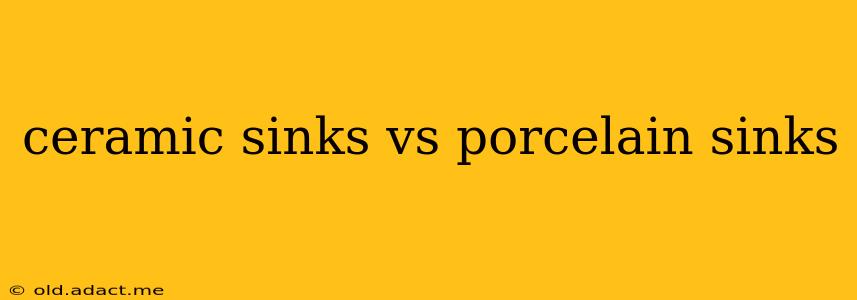Choosing the right sink for your kitchen or bathroom can significantly impact both the aesthetics and functionality of your space. Ceramic and porcelain sinks are popular choices, but understanding their differences is crucial for making an informed decision. This comprehensive guide will delve into the key distinctions between ceramic and porcelain sinks, helping you determine which material best suits your needs and preferences.
What is a Ceramic Sink?
Ceramic sinks are made from a blend of clay and other minerals, fired at high temperatures to create a durable, water-resistant surface. They are known for their versatility in design and color options. However, the term "ceramic" is quite broad, encompassing a range of materials and manufacturing processes, leading to variations in quality and durability.
What is a Porcelain Sink?
Porcelain sinks are a specific type of ceramic sink. They are created using a refined, high-quality clay mixture and are fired at even higher temperatures than standard ceramic sinks. This process results in a denser, more non-porous material that is exceptionally durable and resistant to staining and chipping. Essentially, porcelain is a superior type of ceramic.
Ceramic Sinks vs. Porcelain Sinks: Key Differences
Here's a breakdown of the core differences between ceramic and porcelain sinks:
Durability and Strength:
- Porcelain: Porcelain sinks boast superior durability. Their denser composition makes them highly resistant to chipping, cracking, and scratching. They can withstand heavy use and impacts better than standard ceramic sinks.
- Ceramic: Ceramic sinks, depending on the manufacturing process, can exhibit varying levels of durability. Lower-quality ceramic sinks may be more susceptible to damage.
Stain Resistance:
- Porcelain: The non-porous nature of porcelain makes it exceptionally resistant to stains. Spills and residue are less likely to penetrate the surface, making cleaning easier.
- Ceramic: Ceramic sinks can be more prone to staining, particularly if they are not properly glazed or if the glaze is damaged.
Cleaning and Maintenance:
- Porcelain: Porcelain's non-porous surface simplifies cleaning. A simple wipe-down is often sufficient to remove most stains and dirt.
- Ceramic: Cleaning ceramic sinks might require more effort depending on their porosity. Stains may require more scrubbing or specialized cleaners.
Cost:
- Porcelain: Generally, porcelain sinks are more expensive than standard ceramic sinks due to the higher quality materials and manufacturing process.
- Ceramic: Ceramic sinks offer a wider range of price points, with some budget-friendly options available.
Design and Variety:
- Porcelain: Porcelain sinks are available in a variety of styles and designs, but the range might be slightly smaller compared to ceramic sinks.
- Ceramic: Ceramic sinks offer a broader range of colors, shapes, and designs, providing greater flexibility for different interior styles.
What are the pros and cons of ceramic sinks?
Pros: Wide variety of styles and colors, generally more affordable than porcelain.
Cons: Can be less durable than porcelain, more susceptible to staining and chipping, may require more maintenance.
What are the pros and cons of porcelain sinks?
Pros: Extremely durable, highly resistant to stains and scratches, easy to clean, long-lasting.
Cons: More expensive than ceramic sinks, might have a smaller selection of styles and colors compared to ceramic.
Are porcelain sinks better than ceramic sinks?
Whether porcelain or ceramic is "better" depends entirely on your priorities and budget. Porcelain offers superior durability and stain resistance, making it a long-term investment. However, ceramic sinks provide more affordable options and a wider range of design choices.
How do I clean a ceramic sink?
Cleaning a ceramic sink depends on its glaze and porosity. Generally, warm soapy water and a non-abrasive sponge or cloth are sufficient. For stubborn stains, use a mild cleaner specifically designed for ceramic surfaces. Avoid abrasive cleaners or scouring pads, as these can damage the finish.
How do I clean a porcelain sink?
Cleaning a porcelain sink is usually straightforward. Warm soapy water and a soft cloth are typically all that's needed. Its non-porous surface prevents stains from penetrating, making it easy to maintain its pristine condition.
By carefully considering the differences outlined above, you can confidently choose the sink that best balances your aesthetic preferences, budget, and long-term needs. Remember to consider the specific features and quality of each sink before making a purchase, as variations exist within both ceramic and porcelain categories.
